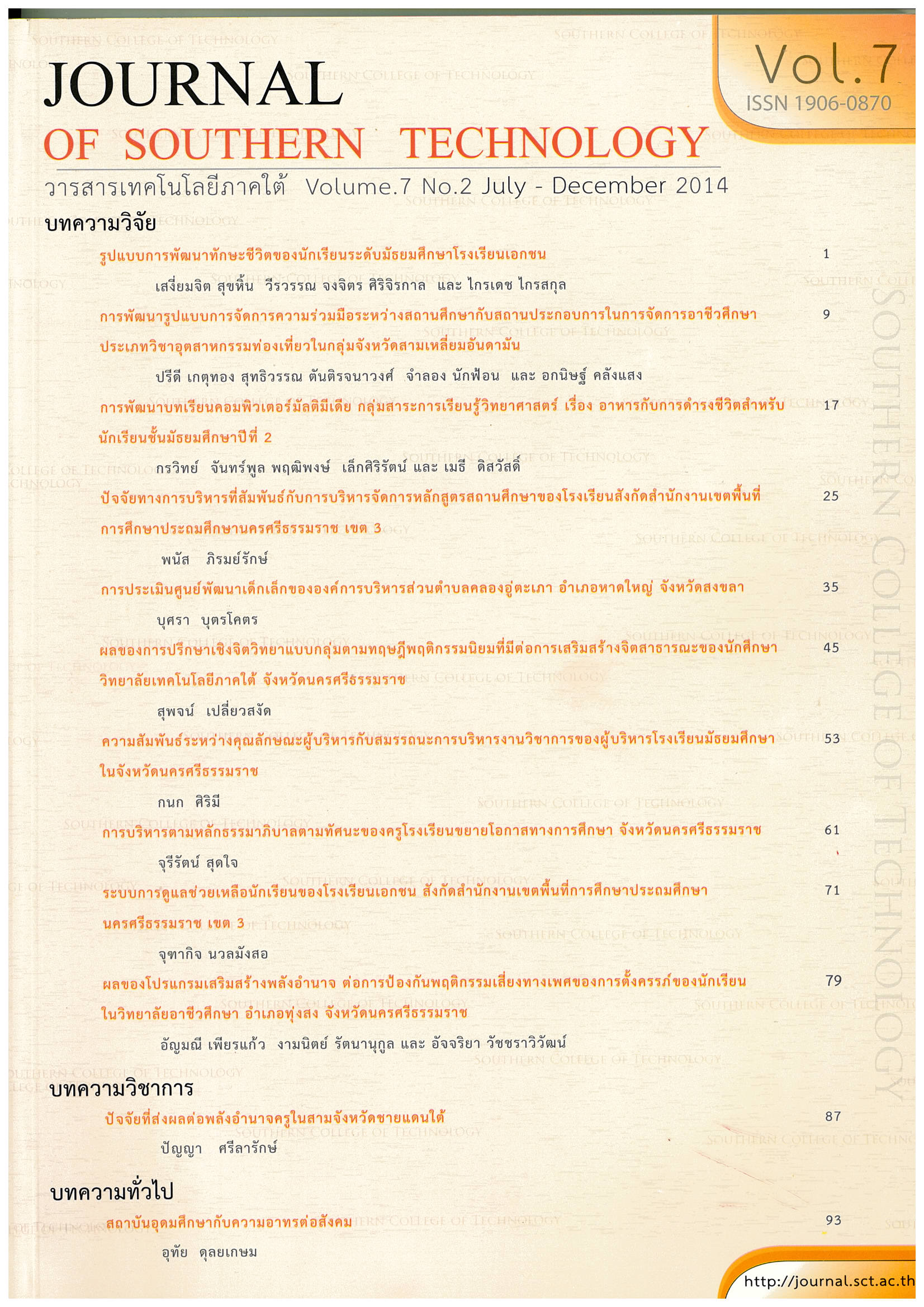การพัฒนาบทเรียนคอมพิวเตอร์มัลติมีเดีย กลุ่มสาระการเรียนรู้วิทยาศาสตร์ เรื่อง อาหารกับการดำรงชีวิต สำหรับนักเรียนชั้นมัธยมศึกษาปีที่ 2
Main Article Content
Abstract
งานวิจัยนี้มีวัตถุประสงค์เพื่อ (1) พัฒนาบทเรียนคอมพิวเตอร์มัลติมีเดีย กลุ่มสาระการเรียนรู้วิทยาศาสตร์ เรื่อง อาหารกับการดำรงชีวิต สำหรับนักเรียนชั้นมัธยมศึกษาปีที่ 2 ให้มีประสิทธิภาพตามเกณฑ์ 80/80 (2) หาดัชนีประสิทธิผลของบทเรียนคอมพิวเตอร์มัลติมีเดีย (3) เปรียบเทียบผลสัมฤทธิ์ทางการเรียนหลังเรียนจากการใช้บทเรียนคอมพิวเตอร์มัลติมีเดียกับกลุ่มที่เรียนด้วยวิธีการเรียนแบบปกติ และ (4) ศึกษาความพึงพอใจของนักเรียนต่อบทเรียนคอมพิวเตอร์มัลติมีเดีย กลุ่มตัวอย่างเป็นนักเรียนชั้นมัธยมศึกษาปีที่ 2 โรงเรียนหาดใหญ่วิทยาลัย 2 ภาคเรียนที่ 2 ปีการศึกษา 2555 จำนวน 102 คน ซึ่งได้มาด้วยวิธีการสุ่มแบบหลายขั้นตอน เครื่องมือที่ใช้ในการวิจัย ได้แก่ (1) บทเรียนคอมพิวเตอร์มัลติมีเดีย กลุ่มสาระการเรียนรู้วิทยาศาสตร์ เรื่อง อาหารกับการดำรงชีวิต สำหรับนักเรียนระดับชั้นมัธยมศึกษาปีที่ 2 (2) แบบทดสอบวัดผลสัมฤทธิ์ทางการเรียน (3) แบบสอบถามความพึงพอใจ (4) แบบประเมินคุณภาพบทเรียนคอมพิวเตอร์มัลติมีเดีย และ (5) แผนการจัดการเรียนรู้ กลุ่มสาระการเรียนรู้วิทยาศาสตร์ เรื่อง อาหารกับการดำรงชีวิต สถิติที่ใช้ในการวิเคราะห์ข้อมูล ได้แก่ ร้อยละ ค่าเฉลี่ย ค่าเบี่ยงเบนมาตรฐาน และการทดสอบที
ผลการวิจัยพบว่า (1) บทเรียนคอมพิวเตอร์มัลติมีเดียมีประสิทธิภาพเท่ากับ 81.56/86.44 (2) บทเรียนคอมพิวเตอร์มัลติมีเดียมีค่าดัชนีประสิทธิผลเท่ากับ 0.56 (3) ผลสัมฤทธิ์ทางการเรียนหลังเรียนของนักเรียนจากการเรียนด้วยบทเรียนคอมพิวเตอร์มัลติมีเดียสูงกว่านักเรียนกลุ่มที่เรียนด้วยวิธีการเรียนแบบปกติอย่างมีนัยสำคัญทางสถิติที่ .05 และ (4) ความพึงพอใจของนักเรียนต่อบทเรียนคอมพิวเตอร์มัลติมีเดียอยู่ในระดับมากที่สุด (4.55±0.51)
The Development of Computer Multimedia Instruction on “Food and Livelihood” in Science for Grade 8 Students
The objectives of this research were (1) to develop computer multimedia instruction on food and livelihood in science for Grade 8 students to meet the 80/80 standard criteria, (2) to identify the effective index of the developed computer multimedia instruction, (3) to compare the academic achievement of the students who were taught with the computer multimedia instruction and those taught with the conventional lessons, and (4) to study the students’ satisfaction with the computer multimedia instruction. The sample for the study were drawn try using multi-stage sampling, consisted of 102 Grade 8 students attending Hatyaiwitthayalai 2 School during the second semester of the 2012 academic year. The instruments used in the study consisted of (1) the computer multimedia instruction on food and livelihood in science for Grade 8 students, (2) achievement test, (3) students’ satisfaction questionnaire, (4) an evaluation form probing the efficiency of the computer multimedia instruction, and 5) learning plan for the topic of food and livelihood. They were used in the data analysis e.g. percentage, arithmetic means, standard deviations and a T-test independent.
The findings revealed that (1) the developed computer multimedia instruction achieved the efficiency of 81.56/86.44, (2) it showed the effective index of 0.56,
(3) the students who were taught with the computer multimedia instruction indicated higher learning achievement than those taught with the conventional lessons at .05 level of statistically significant, and (4) the students performed a ‘very high’ level of satisfaction with the developed computer multimedia instruction (4.55±0.51).
Article Details
-
Authors must agree to the journal publication rules and allow the editors to edit the manuscripts for publication.
-
Author’s right belongs to the author but Journal of Southern Technology holds the right of first publication and thus allow readers to use the article for the purpose of education but not commercial.

